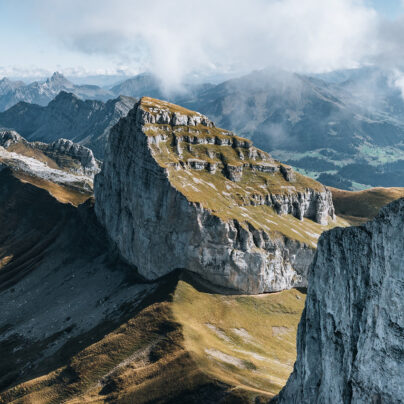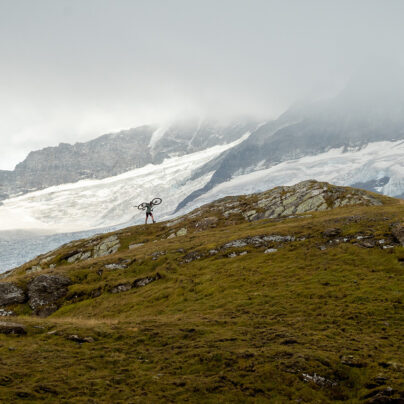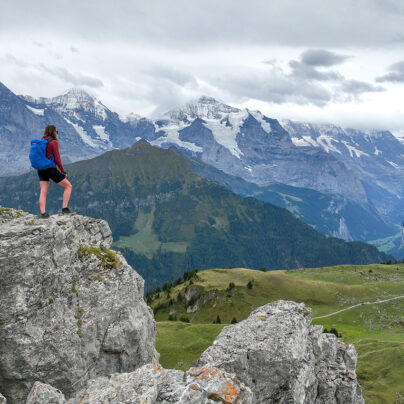Best Laid Plans
Produced in Partnership with Grangers
Daniel Neilson // Photography by Rachel Keenan
As night descended, we lit the lamps and stoves in the bothy and settled in. Rain hammered on the windows through the night and the violent winds outside whistled through the cracks; it was a sleep punctuated by dreams of storms and mountains.
Plans are easy; it’s the execution that is troublesome. Our plan was easy. Meet friends, go to the Highlands, climb a couple of mountains, camp out, have fun, get blown away by the scenery (and hopefully not the weather), return refreshed. There’s an adage among mountain leaders in Scotland though: don’t just have a plan ‘A’ and ‘B’, but also a ‘C’, ‘D’ and ‘E’. This trip, wildly enjoyable as it was, also turned into a fascinating study of decision-making on the mountain. One loaded with the imperatives of recording it for Sidetracked, with the group dynamic, with changing weather, and the elemental conditions of the mountain terrain. Not that we considered these dilemmas the evening before as our group of four arrived at a private bothy in Torridon. This two-bedroom, private bothy at Ben Damph Estate may not have running water, but it did have wood-burning stoves, gas hobs, and comfortable beds. But before we settled in for the night, dinner.
The langoustines were still snapping and flipping when we opened the white box that Barry, our Sherpa for the trip, had brought along. The sun was still an hour before dipping behind the Torridon behemoths, so we headed down to the beach and sparked a little fire. The white-capped rising tide of Upper Loch Torridon sent briny aromas swirling in the air as we threw a knob of butter in the pan and started sizzling the langoustines, plucked hours before from the same loch in front of us. They were cooked within seconds and we tucked in, grabbing the creamy flesh and sucking on the head. We fired up the scallops too and swallowed them down, swigging on a dram of Glenfiddich’s new Fire & Cane single malt. As night descended, we lit the lamps and stoves in the bothy and settled in. Rain hammered on the windows through the night and the violent winds outside whistled through the cracks; it was a sleep punctuated by dreams of storms and mountains. By morning, though, the rains had cleared, and the sky was a mottled grey, punctuated by shafts of sharp sunshine. We checked the MWIS forecast – we should be fine.
But in line with the mountain leaders’ adage and anticipating some good old fashioned highland weather, prior to the trip we had treated the tents with Grangers Tent + Gear Repel. Clothing, not just the waterproofs, had been treated with Wash + Repel Clothing 2 in 1. And so with added protection from the Scottish elements, we packed everything away and headed to the car park far below our destination: the Munros of Beinn Eighe.
Beinn Eighe is a sprawling, complex mountain with Spidean Coire nan Clach and Ruadh Stac Mòr classed as Munros, those Scottish peaks that reach over 3,000ft. Spurs and summits fire off from all angles along the ridge, and burns and rivers tumble down the flanks beneath corries and lochs. The Torridonian Sandstone here is topped with a basal quartzite that gives the peak an almost silver colour that gleams in the sun. The underlying rocks of Lewisian gneiss are among the most ancient anywhere in the world. It all adds up to an overwhelmingly complex and vast topography – so vast that, when an Avro Lancaster crashed in March 1951 above Loch Coire Mhic Fhearchair with the loss of all eight crew members, it took six months to locate all the bodies. A reminder of how our mountain weather can cause tragedy.
We set out with the river Allt á Choire Dhuibh Mhòir raging below us, following a wide, clear track that carves insignificantly between Liathach and Beinn Eighe. Showers exploded above, but within minutes they were gone, revealing patches of blue sky. The mid-afternoon autumn sun was already assuming a golden hue when refracted through the breaks in the cloud. The silvery tops of Wester Ross seemed as if they’d had a dusting of snow, and perhaps they had; it was forecast.





The level of the river had been of concern. As we passed a couple, we asked them of their day. ‘We only got as far as the stepping stones,’ they replied, but went on to explain it was probably manageable. Plan B was already in motion, but first, we’d see. The river roared past in spate, stepping stones just about poking above the water. As John and I stopped to discuss it, our photographer Rachel was already across, looking at us ponderously. We shrugged and hopped across without incident, relieved Plan A was back on the table. Our destination that evening was Coire Mhic Fhearchair, a dramatic corrie holding a loch high in the mountain, and our campsite for the night.
As we circled Sàil Mhòr, the westernmost peak of Beinn Eighe, we heard the roar we’d hoped for. The beginning of October is the stag-rutting season, when the stags roar, rut and mate. It took us a while to find their red-brown hides among the brushes of purple heather and grey rock. But with a flicker of their white rumps, we saw the hinds and a handsome stag. Rachel got her pictures; we grinned. Down the valley continued the drama. I’d seen Torridon on the lochside before, but the great expense of flat-seeming bog, interrupted by mountains that looked almost volcanic, was unlike anything I’d seen. The endless nothingness extended to the horizon and sporadic mountains lumbered through this timeless wilderness like Jurassic monsters. We could see the row of showers lining up towards us like aeroplanes coming in to land, interspersed with bright sunshine. Double rainbows appeared and faded as we pulled up towards the loch. The power of the waterfall falling from the loch caused mini-rainbows in the mist too, below the huge ones arching above us. We could barely hear each other speak above the turbulence. And then our vista opened onto the corrie. Against the back, the Triple Buttress, a well-known climbing location, loomed over the view, almost seeming to fall on us; the loch below it as transparent as a bath, as cold as a Scotch on the rocks.
A flat, sodden area lay before us, and we could see the path curving around the east shore before scurrying up a scree chute. In between, the stepping stones lay more than a foot below the raging water where the flow fell into the gorge below. Not even close to an alternative. We explored options on the south shore, but there were none. We deliberated, our extremities beginning to cool worryingly in the wind. We knew the water level wouldn’t drop. Our summit ambition was over via this route. The options were, then, to spend a long, frigid night (it was only 4.00pm) on this wet patch of land and return in the morning, or return now to our bothy, via the pub. Plan B. It was an easy decision. Mildly annoyed – and mildly pleased we were going to the pub – we started the descent, slowly this time, drinking in the views, spotting more red deer and watching as ferocious rain-filled skies sped past us quicker than we could walk.
In the Torridon Inn, we ordered pints and crisps and discussed our decision-making: who was bolder, who were the advocates, who sided with whom, who trusted whose opinion. Not in an accusatory way at all, but in fascination – major expeditions are wrought with these moments, where decisions can often be life or death. In avalanche safety, mountain leaders talk of heuristic traps, those that are influenced by the group dynamic, by the trust imbued on those who appear more experienced, or perhaps more confident. We returned to the bothy and cooked local venison, drank a couple of drams and slept through the next storm. Plan C would wait for the morning.
We explored options on the south shore, but there were none. We deliberated, our extremities beginning to cool worryingly in the wind. We knew the water level wouldn’t drop. Our summit ambition was over via this route.



We dipped into a lowland forest before coming out after a short walk on to a gently rising open area, with the river Abhainn Coire Mhic Nobuil below to our left. Soon no trees were to be seen in this glacially carved valley.
After our final night in the bothy, we chose a mountain circuit, one where we could descend to camp at safe (and warmer) altitudes by the end of daylight. We laid out our OS maps and studied the options, and realised the best choice was the mountain that had been looming over us since we arrived. Directly across the loch from our bothy was Beinn Alligin, a spiky ring of rock, scarred by horizontal lines reminiscent of those we’d seen in the Faroe Islands. The ‘Horns’, three sabre-tooth-sharp pinnacles to be scrambled over, added a frisson of adventure. Beinn Alligin means ‘Jewelled Hill’.
We drove around the loch and parked by the deep gorge ravished by the frothing white water. I struggled to imagine that this river, even at its most violent, could have hatcheted such a narrow, deep ravine. We dipped into a lowland forest before coming out after a short walk on to a gently rising open area, with the river Abhainn Coire Mhic Nobuil below to our left. Soon no trees were to be seen in this glacially carved valley. We crossed the wooden bridge and as the ascent sharpened so did the weather. Again, we’d seen it coming, this time from across Loch Torridon. Occasional glimpses of blue sky kept us moving, but by the time we’d scrambled to the top of the first ‘horn’, the weather had worsened. None of the mountain before us was visible. The wind had strengthened, and a group ahead of us returned shaking their heads. Another duo coming around the other way said it had taken them seven hours and in relatively decent weather. We shouted over the wind, asking ourselves questions: should we continue? Would it be too dangerous underfoot?

We pushed on for another half hour, the rain now torrential, but it wasn’t long before we’d mutually decided that it wasn’t worth it. The descent back down, still with plenty of hands-on down-scrambling, would require our full concentration. We’d been up for a few hours already and had a wonderful day in the mountains. It’s never an easy decision to turn around, especially when it seemed the sky would clear – but the wind and rain began to wail again soon after, and it set in for the rest of the afternoon. Choice vindicated.
As we set up camp that night, we were able to sit outside in between the showers, enjoy a fire, some more fresh seafood, whisky and banter. We hadn’t achieved the routes that we’d set out to do. But we’d met up, climbed a couple of mountains, camped out, had fun, and returned refreshed. That, after all, was really what Plan A was all about.
Written by Daniel Neilson
Instagram: @danieljneilson
Photography by Rachel Keenan
Instagram: @rachelkeenan9
Produced in partnership with Grangers.
With a heritage spanning more than 80 years and a passion for providing unrivalled protection, Grangers is a British company trusted by active outdoor and sports people around the globe including world-class explorers, climbers, survivalists and everyday adventurers.
Grangers produces superior-performing PFC-free aftercare, which includes tent, gear and technical clothing cleaning and waterproofing solutions.
The first aftercare brand in the world to earn bluesign® system approval in 2007, Grangers remains as committed to sustainability and the environment as it does to delivering unrivalled product protection.
The bluesign® system checks the environmentally-aware credentials of an entire production chain, resulting in a product completely free from harmful substances and processes.
Grangers Tent + Gear Repel is a spray-on waterproofing treatment suitable for use on all outdoor gear and equipment.
Grangers Wash + Repel Clothing 2 in 1 is specially formulated to restore the water-repellent finish of all technical fabrics and provide superior cleaning in a single wash.
For more information visit grangers.co.uk or follow them @grangersofficial








